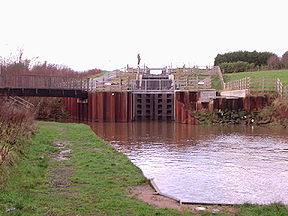| The Millennium Ribble Link | |
|---|---|
 The 3-rise staircase locks | |
 | |
| Specifications | |
| Maximum boat length | 62 ft 0 in (18.90 m) |
| Maximum boat beam | 10 ft 6 in (3.20 m) |
| Locks | 8 (1 tidal gate) |
| Status | Navigable at certain times April–October |
| Navigation authority | Canal & River Trust |
| History | |
| Original owner | The Ribble Link Construction and Operation Limited/The Waterways Trust |
| Principal engineer | Gleeson |
| Other engineer(s) | Arup Water |
| Date completed | 2002 |
| Geography | |
| Start point | Lancaster Canal, Ingol, Preston |
| End point | River Ribble |
The Millennium Ribble Link is a linear water park and new navigation which links the once-isolated Lancaster Canal in Lancashire, England to the River Ribble. The Lancaster Canal was never connected to the rest of the English waterways network, because the planned aqueduct over the River Ribble was never built. Instead, a tramway connected the southern and northern parts of the canal. An idea for a connecting link following the course of the Savick Brook was proposed in 1979, and the Ribble Link Trust campaigned for twenty years to see it built. The turn of the Millennium, and the funds available from the Millennium Commission for projects to mark the event was the catalyst for the project to be implemented, and although completion was delayed, the navigation opened in July 2002.
The link is a navigation, as flows on the Savick Brook can be considerable, and there are large weirs and bywashes at each of the locks, to channel water around them. The lower end of the link is tidal, with boats passing over a rotating gate and through a sea lock to gain access. It is open from April to October, but only on certain days, based on the height of the tide, and boats can only travel in one direction on any one day. The cost of construction was nearly twice the original estimate, with just under half of it funded by the Millennium Commission. The project included footpaths, cycle tracks and a sculpture trail, to attract visitors other than boaters to visit it, and to generate economic returns for the local community. Since its construction, maintenance costs have been high, due to voids developing behind some of the lock walls, and the deposition of silt deposited by the incoming tides.
Although the link is strictly the canalisation of the Savick Brook, the Ribble Link is also used to refer to the crossing from Tarleton on the Rufford Branch of the Leeds and Liverpool Canal, 4 miles (6.4 km) of the River Douglas, the 3.5-mile (5.6 km) journey up the River Ribble and passage along the link to the Lancaster Canal. Completing the crossing requires a little more planning than cruising on inland waterways, as the Douglas, the Ribble, and the first part of the link are tidal, but most boats make the crossing successfully. However, the Royal National Lifeboat Institution have responded to a number of callouts, where the Lytham St Annes lifeboat has had to assist vessels which have got into difficulties.